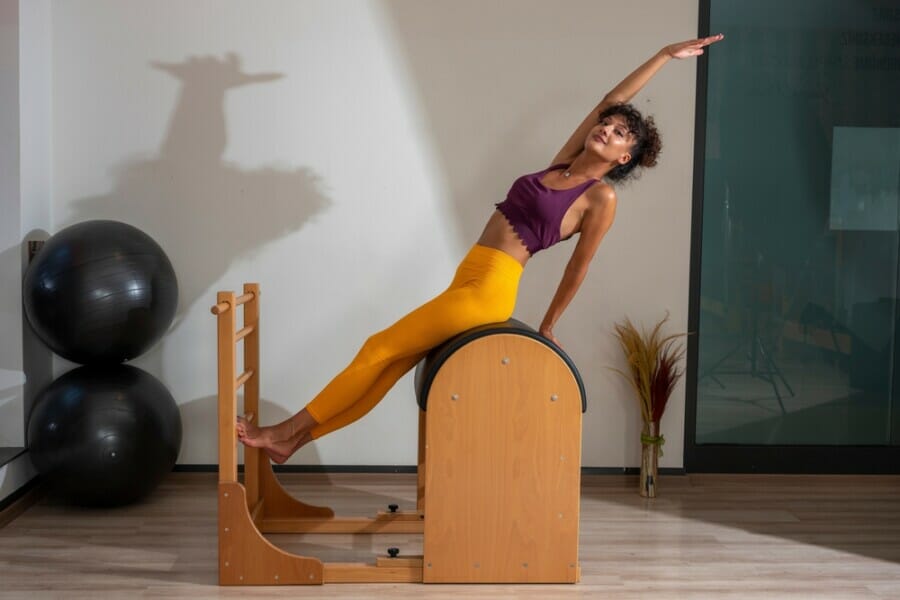Maximize Your Pilates Strength With These 6 Proven Strategies
For generations, Pilates has been celebrated as a transformative workout method, gaining unprecedented popularity in modern times.
Pilates enthusiasts in the United States have surged to nearly 12 million in 2023, marking a 15 percent upswing since the previous year. The term “Pilates” has witnessed a threefold jump in Google queries in the last half-decade, and projections suggest the industry could grow twofold by 2030, according to insights from the Pilates Education Institute. Even pop culture has tipped its hat to Pilates with a dedicated skit on the renowned show SNL.
So, what’s fueling this widespread appeal of Pilates? It’s likely its effective blend of meticulous movements and deep-breathing exercises, paired with an encompassing approach to wellness that catulates to the demands of our hectic, pressure-ridden lifestyles today.
Pilates, a potent combination of both physical and emotional benefits, is accessible and adaptable, suitable for individuals across all walks of life, regardless of age or physical fitness, according to Portia Page, CPT, NCPT, a respected Pilates educator and Balanced Body education program manager.
“Integrate Pilates into your daily regimen to experience its transformative effects,” suggests Page. “It’s uniquely designed to both elongate and fortify your body, focusing on equilibrium, precise alignment, mindful breathing, and fortifying your core. The benefits to both your cognitive and physical health become apparent remarkably swiftly with regular Pilates exercise.”
Engaging in Pilates doesn’t just boost our structural posture—especially beneficial for those of us spending hours hunched over electronic displays—but also our strength and agility. Mentally and emotionally, it also sharpens our breathing technique and culminates in heightened self-assurance as we conquer new challenges, Page elaborates.
However, reaping maximum benefits from your Pilates practice requires attention to certain elements, whether you’re an amateur, a seasoned practitioner, or whether you lean towards mat sessions or prefer working with the reformer.
Below are six key strategies adhered to by Pilates professionals to extract peak value from their practice—and you can do the same.
For newcomers to Pilates— or those short on time or energy—prolonged sessions aren’t imperative. Page advises that even dedicating 10 to 15 minutes daily to Pilates is beneficial, especially for novices. “This timeframe allows you to gradually build your practice and ensure daily quality movement,” Page notes. “Consistent practice inches you closer to perfection, or at least the best you can achieve on any given day.”
1. Prioritize Breathing Techniques
Joseph Pilates famously emphasized, “Above all else, breathing correctly is pivotal,” and this principle is ingrained in the Pilates method. Aligning your breath with each exercise is crucial for maintaining focus and amplifying each movement’s effectiveness, as advocated by Page.
“Using breath to anchor your session helps you and your body arrive at a state of present-moment awareness,” she comments. “Initiating practice with conscious breathing sets the stage for maintaining that focus on breath throughout the workout.”
To better align with your breathing, Jamie Maitland, a certified wellness coach and Pilates instructor, suggests the following steps:
- Place your hands on your ribcage, feeling it inflate on inhales and deflate on exhales.
- Start with just one count for each inhale and exhale.
- Progressively increase up to three to five counts for both inhalation and exhalation once comfortable.
2. Start Your Session with Gradual Warm-Up
Rushing headlong into advanced exercises is a common pitfall, Page points out. It’s akin to swimming: never dive in without first acclimating to the water. Preparing with foundational micro-movements establishes a sturdy foundation crucial for tackling more rigorous exercises and movements later on, says Page.
“By gradually introducing these exercises, it helps us build proficiency and ease into more demanding exercises and movements—one step at a time—rather than forcing or straining into a pose or exercise.”
For guidance on warming up properly, consider attending a Pilates studio or an online class where an instructor can walk you through the necessary steps.
3. Hone Your Alignment
Alignment within Pilates pertains to the position of different body parts like the head, spine, and limbs as they relate to each other during the execution of an exercise. It’s a key concept in Pilates that fosters balance and precision, deriving the maximum effect from each movement, as explained by Maitland.
To observe proper alignment, engaging in a class with an instructor who provides verbal cues or hands-on adjustments can be beneficial, advises Maitland. Additionally, an online class where you can imitate the instructor’s movements or periodically check your form in a mirror can be effective.
Using a towel or strap as a reference point to align knees, feet, and hands during movements may help, as well as Pilates-specific grip socks to prevent sliding and maintain form, suggests Maitland.
To refine your alignment, Page recommends this daily exercise, which can be incorporated into various poses:
- Settle into your chosen position, close your eyes, and take deep breaths.
- Focus on maintaining equilibrium and ensuring your head, ribcage, pelvis, and feet are aligned (if standing). It’s essential to recognize that this alignment will have a distinct feel in each posture.
- Employ your breathing and subtle modifications to find what feels most natural and appropriate for your body (which ultimately is the priority).
“Prioritize precision over volume—remind yourself to concentrate on executing your movements with exactness and care, instead of fixating on speed. Less indeed can be more.” —Jamie Maitland, certified Pilates instructor
4. Aim for a Slow, Measured Pace
Pilates eschews speed in favor of meticulous, controlled movement, advises Maitland.
“Prioritize the detail and substance of your technique rather than rushing through it—being methodical outweighs quantity,” she indicates.
To gauge your pace, Maitland offers a pointer: if you’re breezing through the exercise without focus, you’ll likely only feel a ‘bounce’ rather than the targeted muscles engaging. Slowing down, engaging your core, and isolating movement to work the intended muscles, such as your glutes during leg lifts, will intensify sensation and efficacy.
A proper cadence can be identified if you begin to feel a burn in the working muscle within a brief duration of five to ten seconds.
5. Concentrate Fully During Practice
Pilates strives to nourish and invigorate the body, mind, and spirit, thus, full engagement and absence of distractions is essential.
“A frequent mistake observed during sessions is lack of concentration,” notes Maitland. “Those who ‘zone out’ tend to lose form, as opposed to those fully present and concentrated. Given Pilates is an intellectually involving workout, focus is paramount.”
If you find your concentration waning, Maitland recommends a quick trick: rub your thumb and index finger together to quickly reconnect to the present moment.
6. Introduce Equipment to Elevate Your Workout
It’s well-acknowledged that Pilates doesn’t inherently require equipment for an effective workout. However, for those seeking to up the challenge, integrating equipment such as resistance bands, weighted balls, or dumbbells can intensify any Pilates workout. Maitland lauds Pilates rings as an especially useful tool for injecting variety and added intensity.
Maitland shares a favorite Pilates ring exercise:
- Lay back with knees bent and feet firmly planted.
- Position the Pilates ring between your thighs.
- Raise your legs to a tabletop pose, knees at 90 degrees (or keep your feet grounded for a simpler version).
- Methodically squeeze and release the ring with your inner thighs, then reset.
- Conduct 15 full squeezes, followed by 15 pulses (smaller, partial movements).
- Hold the squeeze for a count of 15.
- Redo the sequence three to four times.














